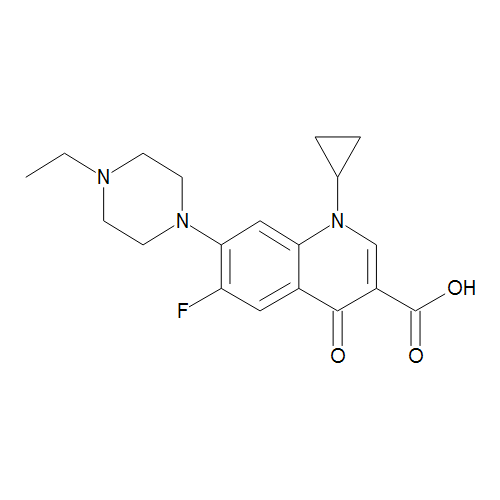Enrofloxacin is a broad-spectrum fluoroquinolone antibiotic used for both therapeutic and non-therapeutic purposes in veterinary medicine. Originally developed and marketed by Bayer in the 1980s, it was one of the earliest members of the fluoroquinolone drug class. Enrofloxacin has since become a commonly prescribed veterinary antibiotic for treating a wide range of bacterial infections in various animal species.
Mechanism of Action
Like other fluoroquinolones, enrofloxacin works by inhibiting bacterial DNA gyrase, an essential enzyme involved in DNA replication. By blocking DNA gyrase activity, enrofloxacin prevents bacteria from unwinding and replicating their DNA, leading to their death or inactivation. This mechanism of action gives enrofloxacin bactericidal properties against both Gram-positive and Gram-negative bacteria. It is considered a broad-spectrum antibiotic as it can effectively treat a diverse range of infectious organisms.
Approved Uses and Regulations
Enrofloxacin is primarily indicated and approved for therapeutic use in livestock such as cattle, pigs, and poultry to treat respiratory, skin, soft tissue, and urinary tract infections caused by susceptible bacteria. Some key approved pathogens it can treat include E. coli, Pasteurella, Salmonella, and Mycoplasma. In many countries, enrofloxacin also has regulatory approval for non-therapeutic use in animal feed or water for disease prevention and growth promotion purposes. However, its non-therapeutic use is now banned in the European Union due to concerns about increasing antimicrobial resistance.
Antimicrobial Spectrum
The broad antibacterial spectrum of enrofloxacin makes it effective against both common gram-positive and gram-negative foodborne pathogens. Susceptible organisms include:
– Common Gram-positives: Staphylococcus aureus (including methicillin-resistant strains), Streptococcus pneumoniae
– Common Gram-negatives: Escherichia coli, Pseudomonas aeruginosa, Salmonella spp., Shigella spp., Campylobacter jejuni, Yersinia enterocolitica
– Other bacteria: Mycoplasma spp., Chlamydia spp., Neisseria gonorrhoeae, Legionella pneumophila
Enrofloxacin also demonstrates in vitro activity against certain atypical bacterial pathogens like Coxiella burnetti and Mycobacterium tuberculosis, though clinical efficacy against these has not been conclusively proven. Its broad spectrum gives it a significant advantage over many older-generation antibiotics with narrower activity profiles.
Pharmacokinetics and Metabolism
Following oral or parenteral administration, enrofloxacin is readily absorbed into the bloodstream and distributed throughout the body, including to key extravascular tissues like the lungs, liver, kidneys, and prostate. Peak plasma concentrations are typically achieved within 1-2 hours. It is metabolized in the liver via oxidation and conjugation into several biologically active metabolites before being eliminated from the body. The primary excretion routes are via feces (bile) and to a lesser extent, urine. Enrofloxacin has a duration of action ranging from 8-24 hours depending on dosage and route.
Toxicity and Side Effects
Like other fluoroquinolones, enrofloxacin is considered relatively safe when used judiciously under veterinary supervision. However, adverse effects in animals may include gastrointestinal upset, loss of appetite, lethargy, behavioral changes, lameness, and tendon inflammation/ruptures. Hypersensitivity reactions are rare but can potentially occur. Long-term toxicity studies required for human drug approval have not been conducted extensively for enrofloxacin’s veterinary applications. Some concerns have also been raised about immunosuppressive effects from non-therapeutic fluoroquinolone usage.
Additionally, as with all antimicrobial agents, prudent usage of enrofloxacin is crucial to prevent emergence of resistant bacterial strains. Indiscriminate overuse or misuse for non-indicated conditions promotes development of resistance, which can limit treatment options in the future and jeopardize human and animal health. For this reason, judicious prescription under veterinary guidance alone is strongly advocated.
Antimicrobial Resistance Issues
Frequent global usage of enrofloxacin in food animal production over the past few decades has been linked to increasing resistance among bacteria like E. coli, C. jejuni, and Salmonella. Resistance is primarily encoded by mutations in bacterial targets like DNA gyrase that decrease drug binding affinity. Resistance genes can also spread between bacteria via mobile genetic elements like plasmids, exacerbating the problem.
Point mutation-derived fluoroquinolone resistance has emerged in many Campylobacter isolates from poultry and food products. Certain Salmonella strains from cattle and pigs have also shown elevated resistance, potentially related to non-therapeutic enrofloxacin exposure. Such resistance complicates treatment of animal and human infections alike. It underscores the importance of antimicrobial stewardship through veterinary oversight, prudent diagnosis-based prescribing practices, and limiting non-medical class-wide uses like growth promotion.
Usage Guidelines and Status
Due to widespread resistance issues, global regulatory attitudes towards enrofloxacin are evolving. While approved for production uses in some regions, the FDA no longer considers enrofloxacin or other fluoroquinolones categorically safe and effective for animal growth promotion and feed efficiency under their NADA (new animal drug application) regulations. The WHO also advises restricting all fluoroquinolone usage to therapeutic purposes only in animals and humans. Additionally, due to emerging resistance in livestock-associated pathogens, alternatives are increasingly recommended as first-line choices for many common food animal infections.
*Note:
1. Source: Coherent Market Insights, Public sources, Desk research
2. We have leveraged AI tools to mine information and compile it



